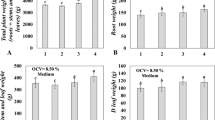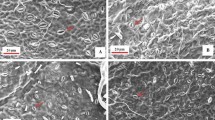Abstract
Paulownia is a fast-growing deciduous tree belonging to the family Paulowniaceae. It is cultivated for obtaining solid wood production in short time. The rapid progress of transgenic biotechnology has significantly enhanced development and production of different genetically modified plants including Paulownia. This study compared morphological and physiological variations of transgenic different Paulownia species (Paulownia tomentosa and Paulownia hybrid 9501) expressing two different thionin genes compared to non-transgenic lines. The morphological parameters were not affected by thionin gene transformation. Further, significant difference between the transgenic and non-transgenic lines of both Paulownia species was not observed. The estimated physiological parameters included chlorophyll content, total soluble sugars, total phenolic compounds, total flavonoids and total proteins. Some of these parameters showed significant difference between the transgenic and non-transgenic lines of the two different Paulownia species. Whereas the other parameters like phenolics and flavonoids did not show significant difference. ISSR molecular marker showed polymorphism percentage between the transgenic and non-transgenic Paulownia lines (i.e. 41.01% in P. tomentosa and 46.86% in P. hybrid 9501).


Similar content being viewed by others
Availability of data and material
All data materials are available in manuscript.
Code availability
Not applicable.
References
Abdel Razik AB (2012) evaluation of the genetic stability of in vitro-propagated Paulownia tomentosa using DNA-based markers. Egypt J Genet Cytol 41:151–161
Bradford MM (1976) A rapid and sensitive method for the quantitation of microgram quantities of protein utilizing the principle of protein-dye binding. Anal Biochem 72:248–254
Cingel A, Savić J, Ćosić T, Raspor M, Ghalawenji N, Smigocki A, Ninković S (2015) Phenotypic performance of transgenic potato (Solanum tuberosum L.) plants with pyramided rice cystatin genes (oci and ocii). Arch Biol Sci Belgrade 67(3):957–964
Edwards K, Johnstone C, Thompson C (1991) A Simple and rapid method for the preparation of plant genomic DNA for PCR analysis. Nucleic Acid Res 19:1349. https://doi.org/10.1093/nar/19.6.1349
El-Khishin DA, Abdul Hamid A, El Moghazy G, Metry EA (2009) Assessment of genetically modified potato lines resistant to potato virus Y using compositional analysis and molecular markers. Res J Agric Biol Sci 5:261–271
Hussien ET (2020) Production of transgenic Paulownia tomentosa (Thunb.) steud. using chitosan nanoparticles to express antimicrobial genes resistant to bacterial infection. Mol Biol Res Commun 9(2):55–62
Ivanova B, Yancheva S, Bojinov B (2012) Molecular differentiation of Paulownia species and hybrids. J Cent Eur Agric 13(1):73–84
Kujala TS, Loponen JM, Klika KD, Pihlaja K (2000) Phenolics and betacyanins in red beetroot (Beta vulgaris) root: distribution and effect of cold storage on the content of total phenolics and three individual compounds. J Agric Food Chem 48(11):5338–5342
Magar LB, Shrestha N, Khadka S, Joshi JR, Acharya J, Gyanwali GC, Marasini BP, Rajbahak S, Parajuli N (2016) Challenges and opportunity of in vitro propagation of Paulownia tomentosa steud for commercial production in Nepal. Int J Appl Sci Biotechnol 4(2):155–160
Metzener H, Rau H, Senger H (1965) Untersuchungen zur Synchronisierbarkeit einzelner PigmentmangelMutanten von Chlorella. Planta 65:186–194
Rafighi A, Tabarsa T (2011) Manufacturing High performance wood composite panel from Paulownia. Key Eng Mater 471–472:1091–1094. https://doi.org/10.4028/www.scientific.net/KEM.471-472.1091
Renata CL, Adriana PV (2016) Paulownia tomentosa L. in vitro propagation. In: Natural resources and sustainable development, pp 30–37
Roy PK (2015) In vitro plant regeneration of Paulownia tomentosa (thumb.) steud. from shoot tip and leaf segment. Bangl J Bot 44(3):459–463
Saker MM, Mohamed AA, Aly AA (2011) Comparative analysis of transformed potato microtubers and its non-transformed counterpart using some biochemical analysis along with inter simple sequence repeat (ISSR) marker. Afr J Biotech 10(34):6401–6410
Schauzu M (2000) The concept of substantial equivalence in safety assessment of foods derived from genetically modified organisms. AgBiotechNet. ABN 044. http://www.bfr.bund.de/cm/245/schauzu.pdf
Shuaib M, Zeb A, Ali Z, Ali W, Ahmad T, Khan I (2007) Characterization of Wheat Varieties by Seed Storage Protein Electrophoresis. African J Biotech 6:497–500
Umbriet WW, Burris RH, Stauffer JF, Cohen PP, Johanse WJ, Lee Page GA, Potter VR, Schneided WC (1959) Monometric technique: a manual description method applicable to study of describing metabolism. Burgess Publishing Company, p 239
Wenjuan M, Jianmin F, Jie Q, Lili L, Fangdong L, Dey Y, Qiandong Q (2013) ISSR Study on Genetic Relationship of Genus Paulownia. Scientia Silvae Sinicae. Food and Agriculture Organization of The United Nations. http://agris.fao.org/agris-search/search.do?recordID=CN2014001303
Yadav NK, Vaidya BN, Henderson K, Lee JF, Stewart WM, Dhekney SA, Joshee N (2013) A review of Paulownia biotechnology: a short rotation, fast growing multipurpose bioenergy tree. Am J Plant Sci 4:2070–2082
Yaycili O, Alikamanoglu S (2005) The effect of magnetic field on Paulownia tissue cultures. Plant Cell, Tissue Organ Cult 83:109–114
Zhishen J, Mengcheng T, Jianming W (1999) The determination of flavonoid contents in mulberry and their scavenging effects on superoxide radicals. Food Chem 64:555–559
Acknowledgements
The authors are grateful to Agriculture center to genetic engineering and biotechnology (ACGEB), Faculty of Agriculture, Ain Shams University; and Genetic lab in Botany and Microbiology Department, Faculty of Science, Helwan University for providing the tools and conditions for this work. Special thanks to Dr. Eman Zakaria (Lecturer of Plant Physiology, Botany and Microbiology Department, Faculty of Science, Helwan University) for help in the physiological measurements.
Funding
No funding received for this work.
Author information
Authors and Affiliations
Contributions
Conceptualization: ABAR and ET; Methodology: ET; Formal analysis and investigation: ET; Writing—original draft preparation: ET; Writing – review and editing: ET; Resources: ABAR and ET; Supervision: ABAR and ET.
Corresponding author
Ethics declarations
Conflict of interest
Dr. Tawfik has nothing to disclose.
Ethics approval
Not applicable.
Consent to participate
All authors agree to the content of manuscript.
Consent for publication
All authors agree for publication.
Additional information
Publisher's Note
Springer Nature remains neutral with regard to jurisdictional claims in published maps and institutional affiliations.
Rights and permissions
About this article
Cite this article
Tawfik, E., Abdel Razik, A.B. Comparative study of morphological and physiological variations of transgenic and non-transgenic Paulownia tomentosa and hybrid Paulownia (9501) tree. Vegetos 35, 1047–1053 (2022). https://doi.org/10.1007/s42535-022-00388-1
Received:
Revised:
Accepted:
Published:
Issue Date:
DOI: https://doi.org/10.1007/s42535-022-00388-1




